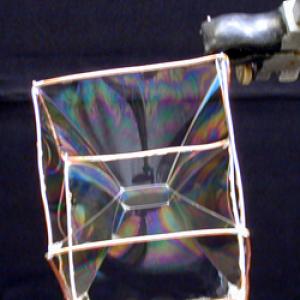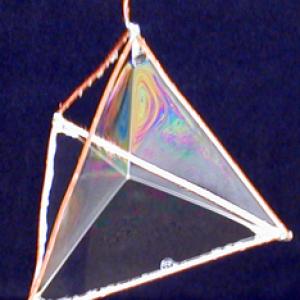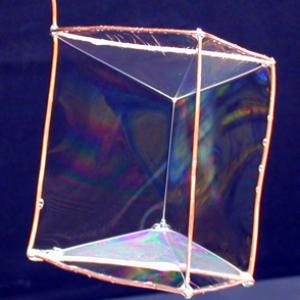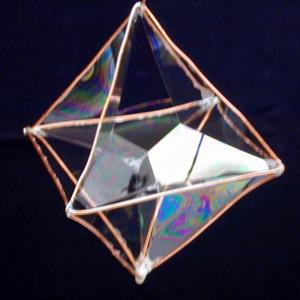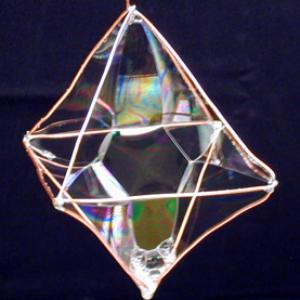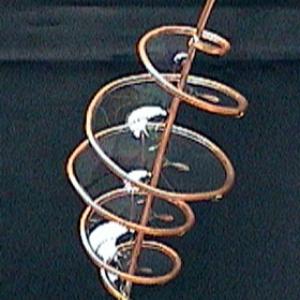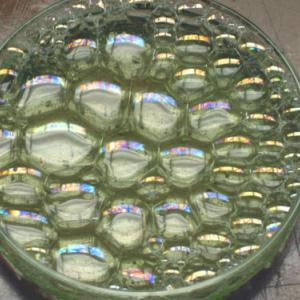College of Liberal Arts & Sciences
2A15.20 - Soap Film - Minimal Surfaces
Dip the frames into the soap bubble solution and draw out slowly. The minimum energy figures should be produced automatically when drawn from the soap bubble solution. Several of these figures will have multiple minimum energy configurations.
Blowing soap bubbles in a confined container such as a Petri dish will give bubbles with straight edges. Mostly the bubbles will be 5 and 6 sided bubbles.
- Woo-Jin Oh, Hogul Park, Seoung-Hey Paik, "Development of Operational Observation Tools for Modeling Spatial Division Patterns", TPT, Vol. 60, #9, Dec. 2022, p. 785.
- Gordon R. Gore, "Playing with Bubbles", TPT, Vol. 36 # 8, Nov. 1998, p. 502.
- Cyril Isenberg, "Problem Solving with Soap Films", TPT, Vol. 15, # 1, Jan. 1977, p. 9.
- David W. Weiser, "A Blind Physicist", TPT, Vol. 15, # 3, Mar. 1977, p. 132.
- Ernest K. Chapin, "The Strange World of Surface Film", TPT, Vol. 4, # 6, Sept. 1966, p. 271.
- Fred Fischer, "Four-Bubble Clusters and Menelaus' Theorem", AJP, Vol. 70, # 10, Oct. 2002, p. 986.
- F. L. Roman, J. Faro, S. Velasco, "A Simple Experiment For Measuring The Surface Tension Of Soap Solution", AJP, Vol. 69, # 8, p. 920, Aug. 2001.
- Sydney Ross, "Cohesion of Bubbles in Foam", AJP, Vol. 46, # 5, May 1978, p. 513.
- Laxmipuram P. Srivatsa, "Bubble Model of Crystal Structure", AJP, Vol. 40, #2, Feb. 1972, p. 338.
- Richard J. Fitzgerald, "Soap Halos", Physics Today, Vol. 72, #7, July 2019, p. 68.
- Johanna Miller, "Separating Scales to Model Bursting Bubbles of Soap and Other Liquids", Physics Today, July 2013, p. 17.
- J. C. Bird et al., "Bursting Bubbles", Physics Today, July 2010, p. 72.
- Douglas J. Durian, Srinvasa R. Raghavan, "Making a Frothy Shampoo or Beer", Physics Today, May 2010, p. 62.
- Yves Pomeau and Emmanuel Villermaux, "Two Hundred Years of Capillarity Research", Physics Today, March 2006, p. 39.
- F- 360: "Soap Films on Wire Frames", DICK and RAE Demo Notebook.
- Flora Lichtman, "The Science of
- Bubbles", Popular Science, June 2014, p. 31.
- Pat Murphy, Ellen Macaulay, and the staff of the Exploratorium, "Handful of Bubbles", Exploratopia, p. 110.
- Jearl Walker, "2.76, Bubbles in Soda, Beer, and Champagne", The Flying Circus of Physics, p. 113.
- "Soap Bubbles", The Exploratorium Science Snackbook, p. 88.1 - 88.2.
- W. Bolton, "Bubble Rafts", Book I - Properties of Materials, Physics Experiments and Projects, 1968, p. 5-6.
- The Queen Catalogues Vol. II, Catalogue of Physical Instruments, No. 4039, p. 3.
Disclaimer: These demonstrations are provided only for illustrative use by persons affiliated with The University of Iowa and only under the direction of a trained instructor or physicist. The University of Iowa is not responsible for demonstrations performed by those using their own equipment or who choose to use this reference material for their own purpose. The demonstrations included here are within the public domain and can be found in materials contained in libraries, bookstores, and through electronic sources. Performing all or any portion of any of these demonstrations, with or without revisions not depicted here entails inherent risks. These risks include, without limitation, bodily injury (and possibly death), including risks to health that may be temporary or permanent and that may exacerbate a pre-existing medical condition; and property loss or damage. Anyone performing any part of these demonstrations, even with revisions, knowingly and voluntarily assumes all risks associated with them.
